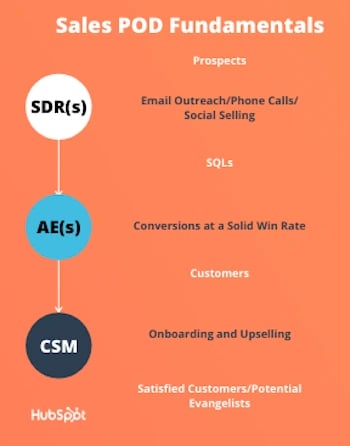Most sales reps work independently. They have their own quotas, are judged by KPIs specific to their individual performance, and often literally compete with their fellow reps. Their operations are often siloed — particularly when it comes to reps operating in different roles.

The sales pod format challenges that convention. It's a team structure that binds a handful of reps — operating at different levels within a sales organization — to collaborate, work, and be evaluated as a cohesive unit.
Let's take some time to explore this strategy a bit further and get perspective on how these "pods" are generally structured.
What is a sales pod?
A sales pod is a team of salespeople that works as a cohesive unit. A pod typically contains some combination of SDRs, AEs, and CSMs. A pod essentially functions like an assembly line — with each salesperson fulfilling a specific responsibility that enables the level after them in the pod's sequence.
The size and structure of the average sales pod make the overall strategy customer-centric. Each member of a pod has a hand in guiding the buyer's journey of every customer it serves, giving each rep more visibility into and investment in every stage of their company's sales process. The format also creates an added layer of accountability to a sales organization.
In a pod system, SDRs and AEs aren't independently competing with their fellow reps. Instead, their performance is gauged by how their pods, as singular units, are faring. If an individual rep is struggling, their fellow pod members have a personal stake in helping them work through their blockers and struggles.
That said, the pod structure has its drawbacks. In some cases, it can diminish the individually competitive element of a more conventional sales org structure. That shift might hinder a rep's capacity to independently refine their sales skills and push themselves to grow as a salesperson.
The more fluid, open structure of the format also has its ups and downs. It can be beneficial for reps within a pod to better understand each other's positions and assist with responsibilities, but that kind of consistent back and forth might impede a rep's ability to truly master their specific role.
Sales Pod Team Structure
Generally speaking, a sales pod features some combination of SDRs, AEs, and CSMs. There's no definitive standard for how many of each kind of rep you need on a team, but pods are typically composed of one to two SDRs, one to two AEs, and one CSM.
How a company structures its sales pod strategy is a matter of its own discretion, but some fundamental staples compose the format — specifically when it comes to the positions it involves and the general activities those kinds of reps carry out. Here is a rough depiction of both those aspects.

1. Sales Development Representatives
SDRs are placed at the top of most sales pods. They're expected to generate a certain number of SQLs to pass along to the AEs situated below them in the general pod flow.
The number of SDRs involved in a sales pod is bound to vary from business to business and according to the goals those organizations are looking to achieve — still, most pod models feature just one to two SDRs at the top of the team progression.
2. Account Executives
Once SDRs pass those SQLs along, the AEs in the pod are expected to make something of them. Ideally, they'll be able to routinely close on a significant segment of those leads.
Again, there's no definitive figure for any sort of specific win rate that applies to all businesses. Those standards and expectations will vary from company to company. Like SDRs, there are generally one or two AEs in a given pod. They're almost always in the middle of the sequence.
3. Customer Success Managers
CSMs round out the typical sales pod progression. Once customers are on board, CSMs serve, delight, understand, and potentially upsell them. One of the most — if not the most — important job a CSM has in the context of a sales pod is onboarding.
That's how they bring it all home. It's the paramount moment of the entire pod sequence. Once a customer is acquainted with a company and its product or service, the sales pod progression is essentially complete.
From there, CSMs can serve customers by following up on renewals, getting them acquainted with their company's service team, and carrying out the other essential functions they're responsible for to ensure that customers are getting the most from your product and relationship.
If your sales organization is looking for a way to shake things up and encourage cohesion, the sales pod format is a structure worth exploring. Though they might be unconventional, sales pods help your team members fluidly pass off responsibilities, get to know one another, and better understand and appreciate each other's roles.











